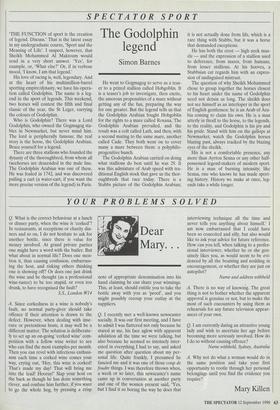SPECTATOR SPORT
The Godolphin legend
Simon Barnes
'THE FUNCTION of sport is the creation of legend. Discuss.' That is the latest essay in my undergraduate course, 'Sport and the Meaning of Life'. I suspect, however, that Sheikh Mohammed Al Maktoum would send in a very short answer. 'Yes', for example, or, 'What else?' Or, if in verbose mood, 'I know, I am that legend.'
His love of racing is, well, legendary. And at the heart of his multimillion-barrel sporting empire/dynasty, we have his opera- tion called Godolphin. The name is a leg- end in the sport of legends. This weekend, two horses will contest the fifth and final classic of the year, the St Leger, carrying the colours of Godolphin.
Who is Godolphin? There was a Lord Godolphin, who owned the Gogmagog sta- bles in Newmarket, but never mind him. The lord is peripherally famous; the real story is the horse, the Godolphin Arabian. Brace yourself for a legend.
There are three stallions who founded the dynasty of the thoroughbred, from whom all racehorses are descended in the male line. The Godolphin Arabian was one of these. He was foaled in 1742, and was discovered pulling a cart (a water-cart, if you want the more precise version of the legend) in Paris. He went to Gogmagog to serve as a teas- er to a prized stallion called Hobgoblin. It is a teaser's job to investigate, then excite, the amorous propensities of a mare without getting any of the fun, preparing the way for one greater. But the legend tells us that the Godolphin Arabian fought Hobgoblin for the rights to a mare called Roxana. The Godolphin Arabian prevailed, and the result was a colt called Lath, and then, with a second mating to the same mare, another called Cade. They both went on to cover many a mare between them: a polyphilo- progenitive bunch.
The Godolphin Arabian carried on doing what stallions do best until he was 29. It was this admixture of Arab speed with tra- ditional English stock that gave us the thor- oughbreds that race today. There is a Stubbs picture of the Godolphin Arabian; it is not actually done from life, which is a rare thing with Stubbs, but it was a horse that demanded exceptions.
He has both the crest — high neck mus- cle — and the expression of a stallion used to deference, from mares, from humans, from lesser stallions. At his hooves, a Stubbsian cat regards him with an expres- sion of undisguised mistrust.
The question of why Sheikh Mohammed chose to group together the horses closest to his heart under the name of Godolphin need not detain us long. The sheikh does not see himself as an interloper in the sport of English gentlemen: he is an Arab of Ara- bia coming to claim his own. He is a man utterly in thrall to the horse, to the legends, to the reality, and Godolphin is his joy and his pride. Stand with him on the gallops at Newmarket, watch the Godolphin horses blazing past, always tracked by the blazing eyes of the sheikh.
His is not a comfortable presence, any more than Ayrton Senna or any other half- possessed legend-makers of modern sport. He is a man of burning intensity; like Senna, one who knows he has made sport- ing history. History we make at once, leg- ends take a while longer.


































































 Previous page
Previous page